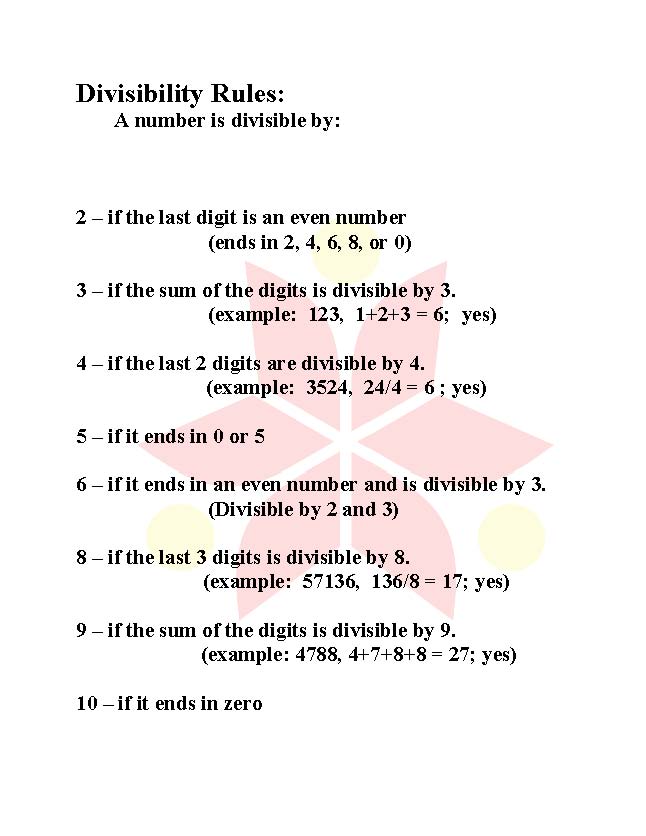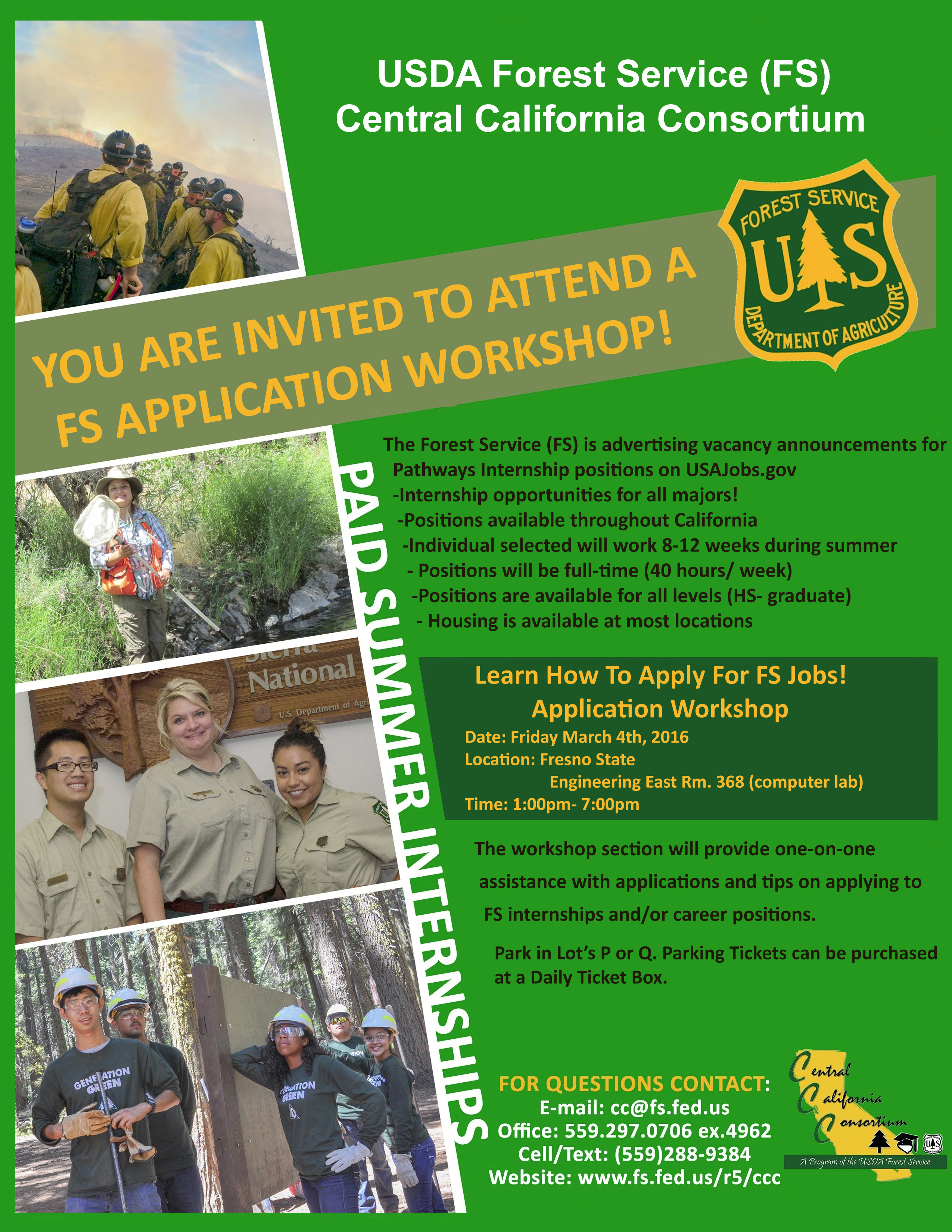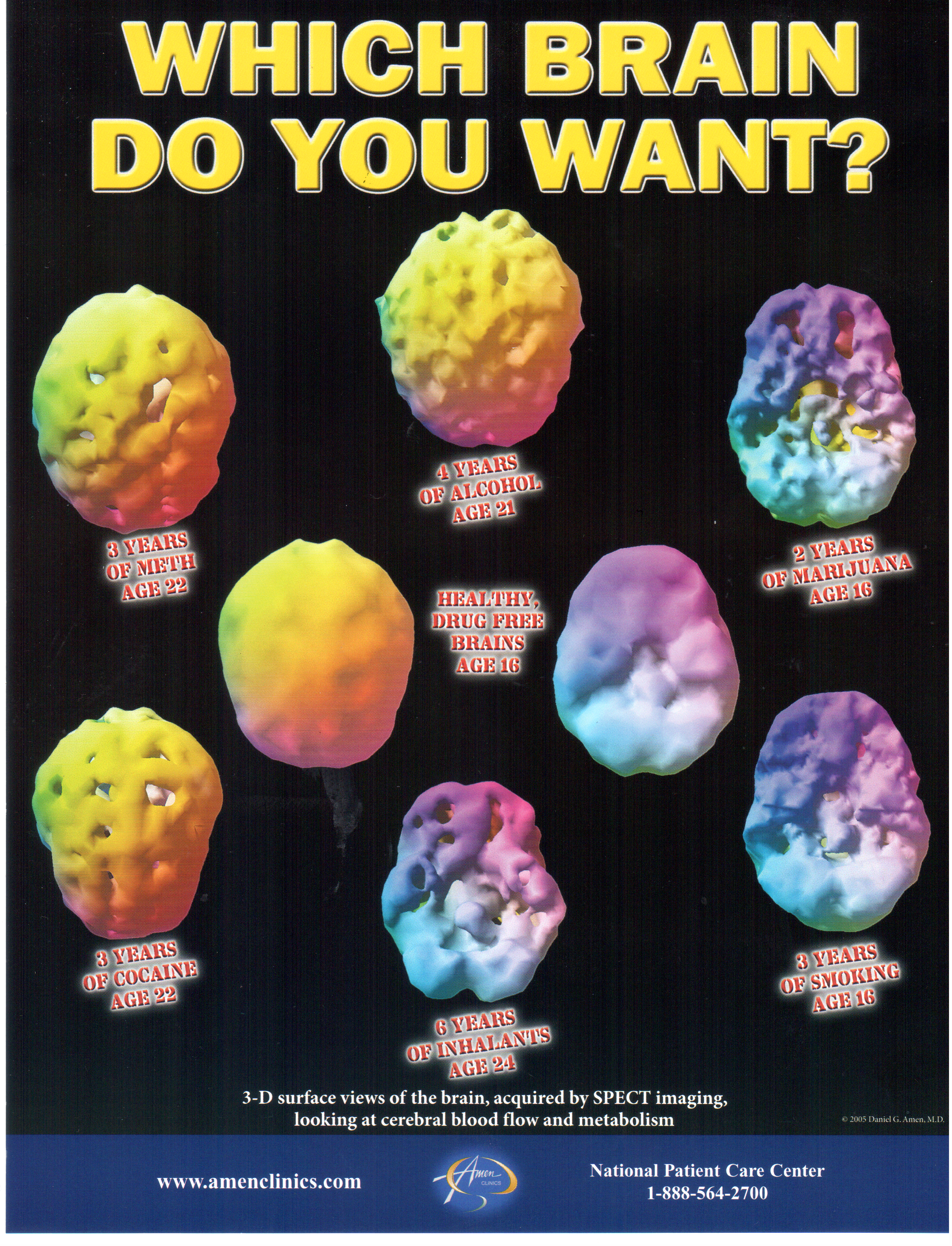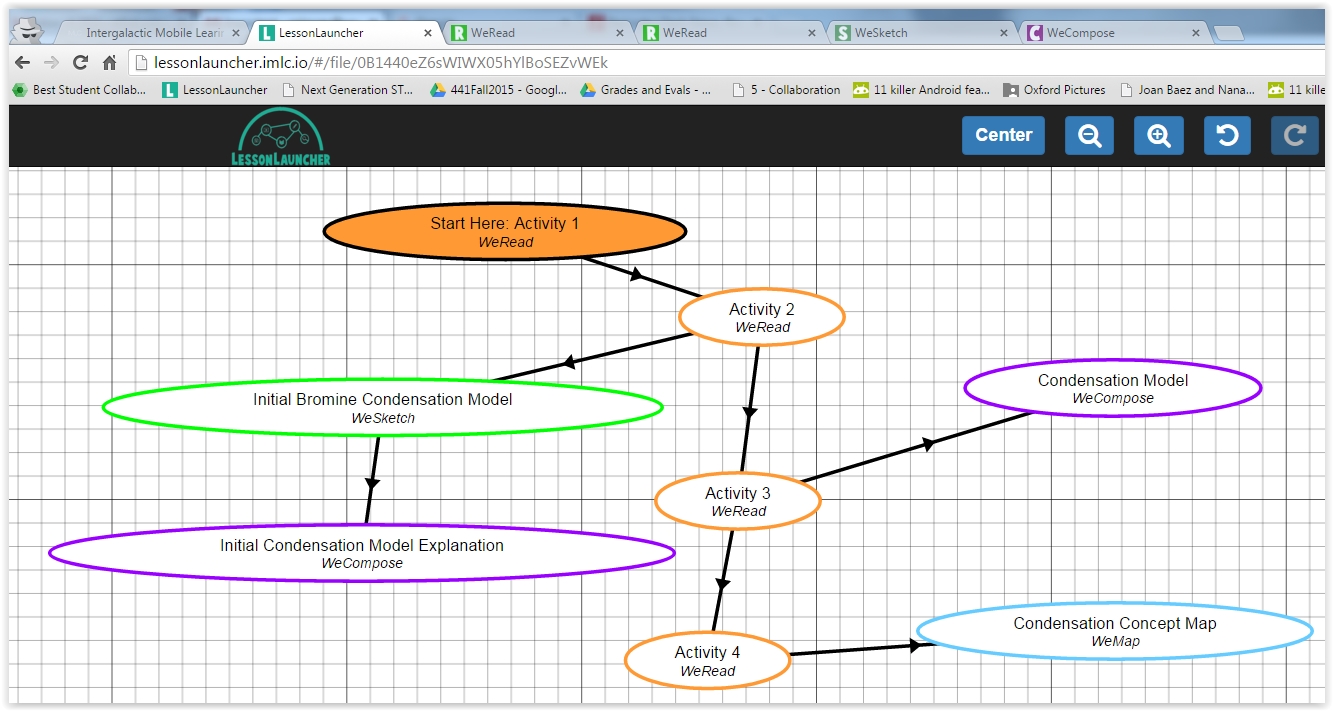Will 2 “gozinta” 23876? How would you know? Check out Divisibility Rules? Numbers are magical.
Category Archives: Educational Support
Forest Service Jobs for Students
The Forest Service is hosting a summer job application workshop from 1:00 p.m. to 7:00 p.m. on Friday March 4, 2016 at the CSU, Fresno Engineering East Building, Room 368 (computer lab). The workshop will provide one-on-one assistance with applications and tips on applying to FS internships and/or career positions. Said positions are entry-level or require minimal work experience and education. Students will work 40 hours per week for up to 8 to 12 weeks during the summer (housing is available at most locations for a minimal fee); pay ranges from $11 to $15 per hour.
All majors are encouraged to apply including: business, administration/clerical, engineering, recreation, biology, geology/hydrology, archaeology, firefighting, range, and many more.
Applications will only be available Mon. February 29 – Fri. March 4, 2016 by 8:59pm (PST); student can apply on USAjobs.gov.
Important: Positions will be added on the following link on February 29, 2016: http://www.fs.fed.us/r5/ccc/internship/Internship.positions.shtml
To apply for the positions with the USDA, Forest Service:
1. log on to www.usajobs.gov. Go to “my accounts” on the upper right hand corner and create a “Profile”
2. Create and upload a government standard resume
View the links below for information on how to create a government standard resume
a. Government Resume Guide: http://www.fs.fed.us/r5/ccc/internship/gov.resume.guide.pdf
b. Sample Resume: http://www.fs.fed.us/r5/ccc/internship/sampleresume.pdf
3. Upload valid school transcripts
Transcripts do not have to be official. However, ensure your transcripts or school enrollment verification documents include the following:
a. Must show your full name and the name of your institution
b. Show name of courses and number of units completed as well as courses in progress
c. Current and Cumulative GPA
d. Enrollment dates, term/quarter or semester and year for courses in progress (ex. Spring semester 2016)
e. We encourage students to submit transcripts from all colleges and universities they attended
4. Apply to Positions of Choice
a. Internship (Pathways) Positions – Applications will only be available February 29-March 4, 2016.
Minimum requirements:
· Maintain good academic standing as defined by the school (typically 2.0 GPA or above)
· Be currently attending or enrolled at least part-time Spring 2016 (typically 6 units) at an accredited school or university
· Be eligible to work in the U.S.(Residents, DACA, Citizens, International students all may apply)
For further information please see the attached flyer.
Juan M. Alvarez
Regional Director
United States Department of Agriculture
Hispanic-Serving Institutions National Program
Central & Northern California / Washington
California State University, Fresno
Craig School of Business / Peters Building
5245 N. Backer Avenue, M/S PB-7
Fresno, CA. 93740-80001
Phone: 559.278.8311
Fax: 559.278.8682
Email: Juan.Alvarez@osec.usda.gov
NEW AIMS CENTER OPEN!
EVERY STUDENT SUCCEEDS ACT PASSES!
Are teachers excited about this? Those in education longer than 15 years know where we used to be and how to find their way forward with the knowledge you have gained. Grab the hands of newer teachers and show us the way.
How do you feel about this new Every Student Succeeds Act?
READ: THE WHITE HOUSE REPORT
Dr. Daniel Amen with Brain Spects
Blended Learning
Blended Learning Is the Future of K-12 Educational Technology
In our blog post of Oct. 6, 2014 we panned blended learning, and now, in what follows, we are about to say blended learning is the greatest thing since sliced bread. If we were politicians we would be labeled as flip-floppers, a derogatory term in the political argot. But, thank goodness we are not politicians, but an educator (C) and a technologist (E) coming to a new understanding of what the future holds, amongst higher-minded colleagues who eschew fallacious ad hominem arguments.
Here’s the reasoning behind the evolution of our thinking:
- We had identified personalized learning – what we are calling personalized learning 1.0 – as the same thing as blended learning.
- And the canonical example of personal learning 1.0, from our perspective, is the Carpe Diem schools, where children sit in cubicles half to three-quarters of the school day, being drilled by some company’s “adaptive learning” system.
- Since we do not feel that the Carpe Diem school model is an appropriate education model, we pooh-poohed blended learning.
Simply put: we painted blended learning with the same brush as personalized learning 1.0. Our bad!
But now … we have seen the light! <Smilely face goes here>
In an excellent 2011 article by Heather Staker of the “Clayton Christensen Institute for Disruptive Innovation” (formerly the Innosight Institute), she defined blended learning as follows:
“Blended learning is any time a student learns at least in part at a supervised brick-and-mortar location away from home and at least in part through online delivery with some element of student control over time, place, path, and/or pace.”
We can easily live with the above definition of blended learning because of the phrase “at least in part through online delivery.” Personalized learning 1.0, e.g. the pedagogy used in Carpe Diem schools, takes online delivery to the extreme, it seems to us. But, as we argue below, what we see coming to K-12 classrooms is absolutely consistent with the definition of blended learning. Please read on!
Here’s the deal: 1-to-1 is the new normal: Between BYOD (bring your own device) and school-provided devices, it is clear that over the next two to three years every student in every classroom in every school in the United States will be using a computing device for learning. Many, many schools in the United States are already at 1-to-1. But the two- to three-year time period is there to acknowledge the sad and disturbing fact that the digital divide still exists, though it’s not talked about very much anymore.
(See a new report by Commonsense Media that documents quite vividly the reality of the digital divide. And ES is experiencing the digital divide first hand in the Detroit Public Schools; 1-to-1 access to a computing device, at least in the elementary schools ES is working in, is still, most disturbingly, a dream. But we digress; we will return to the digital divide, however, in a later blog post.)
In classrooms, then, where there is 1-to-1 access, of course students will spend time, “in part”, during the school day using the computing device to access open-education resources (e.g. informational Web sites, simulations, video) available on the Internet to run apps to support artifact development (create a text-based report augmented with graphical media, develop a concept map, construct a drawing or animation, etc.) and, yes, maybe even to be drilled by some adaptive learning app. Those classroom uses of computing devices are perfectly consistent with the definition of blended learning given above.
For example, Figure 1 (below) depicts a blended learning lesson used in a Michigan sixth-grade science classroom recently. The app mediating the lesson is called “LessonLauncher“; LessonLauncher is written in HTML5 and thus it is device-agnostic – LessonLauncher runs in virtually all browsers (Edge, IE, Safari, Chrome, Firefox, etc.), and LessonLauncher is free. (Interested in using LessonLauncher? Please send ES an e-mail: soloway@umich.edu)
In LessonLauncher, a teacher provides students with a roadmap for a Blended Lesson – a playlist in the millennials argot. For example, in Figure 1, clicking (or tapping if LessonLauncher is running on an iOS/Android/Windows tablet) the “Start Here Activity 1 WeRead” node brings up an article about Bromine and condensation. Clicking (or tapping) on “Initial Bromine Condensation Model WeSketch” brings up the WeSketch app where students can construct a drawing that represents their understanding, their model, of how bromine condensation happens. WeSketch is “collabrified” so two or more students work in WeSketch co-creating that model, in real-time. In total, the computer-mediated lesson depicted in Figure 1 contains eight computer-based learning activities, e.g., reading material on external Web sites, answering questions, drawing a model, etc.
The lesson depicted in Figure 1 is absolutely consistent with the definition of blended learning given by Staker. No, the students enacting the lesson in Figure 1 are not being drilled by an online, adaptive learning program, but the students are going online for some portion of the lesson. (Technically, the students are also online when they are working collaboratively, answering questions, making drawings, since the Internet is being used to keep the collaborators’ artifacts in sync. But the online aspect of those collabrified apps is really a second-order issue.)
Here comes a prediction – and you can take this one to the bank – it’s that solid:
Prediction 1: Over the next two to three years, there will be a dramatic increase in the number of lessons – blended learning lessons – that are computer-mediated and comprise a roadmap, along with the computer-based learning activities, just like the lesson depicted in Figure 1.
Who will produce those computer-mediated lessons? All y’all, as they say in Texas! You, the teachers who are on the cutting edge of technology and education, along with your colleagues who are more curricularly-focused – you all will produce such lessons, post them to a marketplace, e.g., teachers-pay-teachers, Curriki – or maybe a new website devoted to the “blended learning, computer-mediated lesson economy”. And, it will become a standard-operating procedure for teachers to come to that site/those sites to find lessons they can easily tweak for their students.
We are ready to make two more predictions:
Prediction 2: Over the next two to three years a new generation of curriculum-building/distributing/managing tools will come available to enable curriculum-creating teachers and small curriculum-creating companies who are producing this new generation of blended learning, computer-mediated lessons.
Prediction 3: These new tools will foster the explosive growth of a marketplace for computer-mediated lessons – a marketplace that is virtually non-existent today.
Who will produce those tools? Not the mega-textbook companies; they are going the way of the music CD producers. When Prediction 2 happens – and it will – those tools will enable the disrupters to swoop in and take the curriculum business away from the mega-textbook publishers; those tools will enable those disrupters to create – and market – a new generation of computer-mediated lessons!
(Aside: you can take Predictions 2 and 3 to the bank, also; they are as solid as Prediction 1.)
blended learning is indeed the future of computer use in the K-12 classroom. The formulation of blended learning described in this blog post may diverge from the blended learning orthodoxy; no biggy. The fact is, the term “blended learning” does very accurately describe what is happening in a classroom where learners are using their 1-to-1 computing devices to engage in their computer-based, computer-mediated lessons. Yup, blended learning is the future!
Mindfulness In The Classroom
Under Stress, Students in New York Schools Find Calm in Meditation
By ELIZABETH A. HARRISOCT. 23, 2015
Fourth graders at Public School 212 in Queens practice mindful exercises in the classroom. Credit Lindsay Morris for The New York Times
On the first day of the new school year, the schools chancellor, Carmen Fariña, stood in an elementary school classroom in Queens beaming at a hushed room full of fourth-grade children sitting cross-legged on the floor.
“Please let your eyes close,” said a small boy named Davinder, from his spot on the linoleum.
Davinder gently struck a shallow bronze bowl.
Gong!
“Take three mindful breaths,” he said, and the room fell silent.
“Do you do personal visits?” Ms. Fariña asked after the exercise was over. “Like to offices?”
In schools in New York City and in pockets around the country, the use of inward-looking practices like mindfulness and meditation is starting to grow. Though evidence is thin on how well they might work in the classroom, proponents say they can help students focus and cope with stress.
At the Brooklyn Urban Garden Charter School in Windsor Terrace, 15 minutes are set aside at the beginning and end of every school day, when students must either meditate or sit quietly at their desks.
The goal of mindfulness exorcises, practitioners say, is to get students into the habit of calming themselves and their minds. Credit Lindsay Morris for The New York Times
“It’s built into the schedule,” said Linda Rosenbury, founding principal at Brooklyn Urban Garden, a middle school. “Everyone clears off their desks. They shouldn’t be chewing gum, but if they are, they spit it out. Their hands are free. We ring a bell.” A building full of preteens and teenagers goes quiet, she said.
“It used to be that you wouldn’t say ‘meditation’ in polite company,” said Bob Roth, executive director of the David Lynch Foundation, a charitable foundation founded by the director of “Blue Velvet,” that promotes and teaches Transcendental Meditation to adults and children, including those at Brooklyn Urban Garden. “Now we’re working with all the large banks, we’re working with hedge funds, we’re working with media companies. People are having us come in as part of their wellness programs, and that wasn’t the case even two years ago.”
While Transcendental Meditation entails silent inward repetition of a mantra, a mindfulness exercise might ask children to focus on breathing in and out. In a classroom, both activities have similar goals; the idea, practitioners say, is to get students into the habit of calming themselves and clearing their minds so they can better focus on the day’s lesson.
“We’re putting it in a lot of our schools,” Ms. Fariña said about mindfulness, on the first day of school, “because kids are under a lot of stress.”
The Department of Education does not keep track of how many schools have mindfulness programs, but a spokeswoman said that grants and professional development seminars have provided some training to school staff members.
The city’s Move to Improve program has also taught nearly 8,000 elementary school teachers how to use activities in the classroom that can include things like mindfulness, balance exercises and stretching.
In many cases, schools are finding their own way. To mindfulness, in particular.
At Public School 212 in Jackson Heights, Queens, the school Ms. Fariña visited on the first day of classes, a literacy coach named Danielle Mahoney began doing regular mindfulness exercises with some classes the year before last, while taking a one-year certification course.
Last year, the school converted a large closet in a subbasement into a room devoted to mindfulness, complete with dim illumination and a string of rainbow Christmas-tree lights, allowing users to switch off the harsh fluorescent light overhead.
This sort of homegrown effort has created a patchwork effect; “mindfulness” might look a little different in every school.
“It’s a bottom-up process,” said Mark T. Greenberg, a professor of human development and psychology at Penn State. “You have very early adopters who are very interested in the ideas, and they are trying out different ideas and venues.”
Some districts, however, are experimenting with a more holistic approach. In Mamaroneck, N.Y., in Westchester County, the district has funded mindfulness training for teachers and parents in each of its six schools, and is encouraging the use of mindfulness exercises as part of an effort to address the social and emotional needs of students.
In Louisville, Ky., more than half of the city’s public elementary schools are expected to participate in a randomized study next year that will teach mindfulness exercises to some students as part of a so-called health and wellness curriculum.
Donna Hargens, the superintendent of the Louisville district of Jefferson County’s public school system, said that in classrooms a teacher’s reflex is to say, “ ‘Focus! Why aren’t you focusing?’ But what does that really mean, and have we given them any tools to help them do that?”
Research in a classroom setting appears to be picking up steam. In Britain, researchers from Oxford and University College London are studying whether teaching mindfulness in schools can improve the mental health of students, and some studies have shown benefits for many adults. Still, little is truly known about how, or even whether, children benefit from the practice in an academic setting.
“It definitely doesn’t address poverty, and it may not work for everybody,” said Patricia Jennings, an associate professor at the Curry School of Education at the University of Virginia and the author of a book called “Mindfulness for Teachers.”
Mr. Greenberg of Penn State cautioned that even if the practice does provide benefits for students, the research has yet to explain how.
A version of this article appears in print on October 24, 2015, on page A20 of the New York edition with the headline: City Classrooms Give Pupils a Moment to Turn Inward . Order Reprints| Today’s Paper|Subscribe
FREE LESSONS FROM CA STATE PARKS
CALIFORNIA STATE PARK ONLINE RESOURCES FOR TEACHERS AND STUDENTS
Units of Study
PORTS is proud to announce the completion of the PORTS Unit of Study Common Core Alignment Project. All of the Units of Study are aligned to the Common Core State Standards. It has been exciting to note that our videoconference presentations are already aligned with the Speaking and Listening standards prominant in the CCSS:
Speaking and Listening: Flexible communication and collaboration
Including but not limited to skill necessary for formal presentations, the Speaking and Listening standards require students to develop a range of broadly useful oral communication and interpersonal skills. Students must learn to work together, express and listen carefully to ideas, integrate information from oral, visual, quantitative, and media sources, evaluate what they hear, use media and visual displays strategically to help achieve communicative purposes, and adapt speech to context and task.
To register for a PORTS distance learning program, complete the PORTS Registration Form (PDF) and email it to your local PORTS Program Coordinator or the PORTS Interpreter listed for a specific Unit of Study.
PORTS Registration Form (PDF)
5E Lesson Plans
PORTS is piloting a new format for our lesson plans called the 5E that better aligns with the critical thinking skills being promoted by Common Core State Standards and the Next Generation Science Standards . The 5 Es of teaching science with inquiry are Engagement, Exploration, Explanation, Elaboration, and Evaluation. Our newest units of study, Mammals and Monarch Butterfly Life Cycle and Migration, are written in a three column version of the 5E lesson plan that shows teachers what to do and say, what types of probing questions to ask, and how students might respond.
ANCIENT CIVILIZATIONS
Explore the art and architecture of the ancient Greeks and Romans through the art and artifacts of Hearst Castle (6th grade)
Ancient Civilizations Unit of Study
COASTAL RESOURCE PROTECTION – COMING SOON!
Soon students can explore the coastal resources of Point Lobos Natural Reserve and learn how Marine Protected Areas are being used to help protect them.
For now, you can check out the following units of study which are already discussing Marine Protected Areas.
Elephant Seals
Tidepool Ecology
Salmon Lifecycle
Science of Habitat Restoration and Protection
We will also soon unveil our new Marine Protected Areas online modules here.
Coastal Resource Protection Unit of Study
DESERT STORIES TODAY AND YESTERDAY
Explore Anza-Borrego Desert State Park to discover its stories of change, preservation, extinction and protection. (4th and 6th grade)
ELEPHANT SEALS
Students are introduced to the evolutionary history and adaptations of the northern elephant seals at Año Nuevo State Reserve. (7th grade)
GOLD RUSH
Learn about the California Gold Rush from Columbia State Historic Park. (4th grade)
IMMIGRATION
Explore the topic of immigration through the stories and lives of those who came through the US Immigration Station at Angel Island State Park.
MONARCH BUTTERFLY LIFECYCLE AND MIGRATION
Explore the mystery of Monarch butterfly lifecycle and Migration from Natural Bridges State Park. (Kindergarten – 3rd grade)
Monarch Butterfly Life Cycle and Migration Unit of Study
REDWOOD ECOLOGY
Find out about the unique redwood forest ecosystems of Humboldt Redwoods and Prairie Creek Redwoods State Parks. (6th grade)
SALMON LIFECYCLE
Students are introduced to the life cycle of salmon and the importance of watersheds for their survival at Del Norte Redwoods State Park (3rd, 6th grade)
SCIENCE OF HABITAT PROTECTION AND RESTORATION
Students discover how human impacts degrade some of California’s native ecosystems and habitats while getting a first-hand look at the work California State Parks has done to restore the coastal sage scrub habitat at Crystal Cove State Park. (6th-8th Grade)
Science of Habitat Protection and Restoration Unit of Study
STATE GOVERNMENT
Engage students in researching information about their state representatives, the law-making process, and how they, as citizens, have a voice in government. (8th (adaptable for other grades)
State Government Units of Study
TIDE POOLS
Experience life at the ocean’s edge and find out why life in the tide pools is no day at the beach. (4th, 5th grade) new test
WEATHER AND CLIMATE
Baldwin Hills Scenic Overlook is a great place to observe weather. Students will learn about weather, climate and the story of this unique park in Los Angeles. (5th grade)
Weather and Climate Unit of Study
WHAT IS A MAMMAL?
Explore how mammals are different from other animals by learning unique features of mammals and comparing them to reptiles, insects and others. (Kindergarten-2nd grade)
What is a Mammal? Unit of Study
OTHER PROGRAMS
Check out what else we have to offer!
(K-12th grade)
RELATED PAGES
Contact Us
- Address: 1416 9th Street Sacramento, CA 95814 | P.O. Box 942896 Sacramento, CA 94296
- Public Information Inquiries: (916) 653-6995 | (800) 777-0369
- For Specific Park Questions: Contact Us Page
- General Questions: info@parks.ca.gov
Follow Us
Select a Language
Select Language▼
Latest Tweet
Stay tuned to our #TransformationTuesday as cabins go from planning to breaking ground. (Image is artist rendering)https://t.co/s8NS31m0pn1h
Copyright © 2015 State of California
Online Learning That Engages Students
Passion In Education has been utilizing Edgenuity since it’s opening in 2010. We have assisted many students and parents. Students need options in education to meet their needs. If your student is currently struggling and needs another form of learning, check out The Bridge Virtual Academy for support courses, getting ahead, advancing in courses not offered in your current school and more.
Click here for a demo.
Enjoy the learning process. Find what works best for your learning style.







